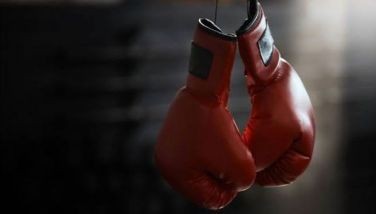Those stupid ‘coup drills’ may boomerang with the real thing
September 4, 2006 | 12:00am
To be frank, this writer was aghast to hear that hundreds of combat-geared troops and two APCs had staged a "surprise" coup drill in Camp Aguinaldo – with the approval of Armed Forces Chief of Staff, Gen. Hermogenes Esperon Jr.
If you ask me, this was a harebrained exercise, accomplishing nothing but alarm outsiders who heard about it while it was ongoing by phone warnings and text messages. Worse some people are inquiring whether it was an actual mutiny simply squelched in time.
Of course, as Jun Esperon insisted, our soldiers must be ready to cope with any emergency – but what did the fake "coup" caper teach them, really? How to stage a coup, not deal with it. The clear and present danger in launching such a tricky maneuver is that true-to-life mutineers are now alerted to the fact that they can sneak in a real coup try camouflaged by such a "drill". In Hollywood-fashion, the denouement might come when a young officer grabs the microphone and announces, "This is not a drill – we have taken over!"
Our generals must not play with fire. Look at the brush and forest fires which just devastated huge tracts in northern Greece and in the tinder-dry forests of Galicia in Spain. Somebody struck a match, and the conflagration raged out of control.
In Galicia, however, where firestorms destroyed much of the forest cover near Corunna, the port incidentally from which the ill-fated Spanish Armada sailed to attack England during the Elizabethan era, arson on a large-scale is suspected, and dozens have already been arrested.
In our military, so many would-be arsonists lurk in the woodwork, that our top brass should go slow in staging a "mock coup." The joke may be on them – and on all of us.
The most deplorable aspect about the "drill" (or was it a drill?) was that the Army, Navy and Air Force participated in the exercise, taking the personnel involved away from their more important and urgent duties. One continues to wonder whether it was something else – which had, thankfully, been nipped in the bud.
We’re all becoming indignant about the Guimaras "oil spill" three weeks too late. It took la Presidenta a week before she flew over to check it out and assess (or minimize) the damage. Petron tried to pooh-pooh it, and evade "responsibility" for the spill, sinking, and seepage. Now, every Tomas, Dickhead and Kulasa is jumping into the act, expressing anger, compassion and wringing hands on television.
Everybody’s buck-passing on the matter, from the Coast Guard to the MARINA, and the ship’s master, whose license had expired over three years ago. The ship master sputtered that he wasn’t to blame. God Almighty! It turns out that fellow had only qualified to handle chemical – not oil – tankers. Doesn’t anybody follow the rules, or get punished for violating regulations or the law in this country? It was outrageous – even criminal – to risk shipping such a large quantity of oil on a creaky, single-hulled chemical tanker like the MT "SOLAR I" – but this is a land where the tears start flowing and the recriminations begin flying about after it’s too late.
From now on, PR statements are now being issued, oil and other such volatile cargo will be shipped only on double-hulled tankers. They should have been warned when there was an earlier oil spill off Semirara last year. But Petron’s officials stubbornly kept to the old contracts and didn’t require double-hulled, safely-built oil tankers capable of surmounting modern hazards.
I’m surprised that they’re still talking about "refloating" or raising that wreck to the surface. At the depth in which the Japanese submersible has located and filmed it, the cost of this would be exorbitant – and, in truth, such a maneuver is not just useless, but might result in additional spillage of oil. They should simply seal off every compartment in which there’s still any residual oil, and cap any further seepage, leaving the small tanker to its quiet grave at the bottom of the sea.
The coastwise tanker, single-hulled, constructed in 1988, and originally named the Maru "New Hinase" was only designed to haul chemicals, before being sold in very old condition to the Sunshine Maritime Development Corp., business address 1993 Mabini st., Manila, and registered here by the Maritime Industry Authority (MARINA) under Official registry number MNLDO10519, in the year 2002.
Once more with feeling, Sunshine Maritime ought not to have utilized such a "coastwise", single-hulled vessel to transport oil in open sea, plying that ill-starred route between Luzon and Zamboanga in Mindanao.
The entire caper is a disgrace – to Petron, to Sunshine Maritime, and to the agencies which should have inspected and monitored – and indeed rejected – the seaworthiness of the MT "SOLAR I" for the handling of dangerous cargo, namely the Philippine Coast Guard and the Maritime Industry Authority (MARINA).
Another source of confusion is the fact that the authority and responsibilities of both government agencies overlap – which results in finger-pointing and buck-passing afterwards.
When nobody is certain who’s ultimately responsible, every time there’s an accident or calamity, nobody will accept the responsibility.
The "ceasefire" in Lebanon may not hold. But even if it does, don’t think that Lebanon is out of danger yet.
Many Lebanese may be "united" in one thing, they’ve found a hate object – the Israeli military – to blame for the destruction visited on their country and the terrible damage to their infrastructure ($3.5 billion in damage has been estimated) but chronic lack of unity is the cause of Lebanon’s past and present tragedy.
Just consider the Lebanese Constitution itself, which acknowledges 18 religious groups (yes, eighteen). These, under the organic law, have the right to handle family law according to their own courts and traditions. These groups, moreover, are not internally homogeneous. For instance, the Maronite Christian, Shi’a and Druze communities have been splintered by internal fighting in recent years.
The 18 categories are Maronite (Maronite Catholic); Greek Orthodox; Greek Catholic (Melkite); Armenian Orthodox (Gregorian); Armenian Catholic; Syriac Orthodox (Jacobite); Syriac Catholic; Roman Catholic (Latins); Copts; Evangelical Christian (including Protestant groups such as Baptists and Seventh Day Adventists); Chaldean Catholic; Nestorian Assyrian; Twelver Shi’a; Sunni (Muslim); Ismaili (Sevener Shi’a); Druze; Alawite; and even Jewish – although few Jews remain in Lebanon today.
Some 200,000 Palestinians in Lebanon and perhaps a million Syrians are not included in the statistic of four million Lebanese since they are not citizens. But, by golly, how can you overlook them?
In 1932, the official census stated that Christians made up 55 percent of the population. The Maronites (who are allied with the Roman Catholic Church, except that their clergy are married) are the largest among Christian sects, accounting for 29 percent of the population. The Maronites used to control most of the state apparatus – but this is no longer true. As a matter of fact, with a much faster birth rate among the Muslims, particularly the Twlever Shi’a, plus the emigration of millions of Christians from Lebanon during the Civil War, and even earlier, the situation has been reversed. The Muslims now constitute at least 60 percent of the population, and even more than that. (In 1990, the Shi’a alone compised 35 percent).
Why do the Shi’as, the ethnic group composing and backing the Hezbollah, now obviously predominate? As traditionally the poorest community, not only had they the highest birth rate (just as our Filipino masa have their "baby factories"), they had no natural emigration outlet either. In contrast, the Christians had many contacts in the United States, Latin America and Europe – therefore many Christians emigrated to those two continents. The Maronites gravitated to Italy and France; the Greek Orthodox groups to Greece and Turkey; and so forth.
There are an estimated ten million Lebanese Christians or their descendants who emigrated over the years. For instance, would you believe, there are 7 million, yep seven million, people of Lebanese descent in Brazil alone.
Experts have explained the large size of Lebanon’s diaspora as owing to the fact that most of that country’s Christians are not Arabs, but descended from the ancient Phoenicians, who were traditionally traders, seafaring men, and travellers who, for example, created a "gateway" through Lebanon between Europe and the Middle East.
The powerful empire of Carthage which, in the Third Century A.D., battled it out with Rome for mastery in the Mediterranean world, was composed of a people of Phoenician origin, developing from one of the early settlements of Tyre (yes, the city-port which was bombed and bombarded relentlessly in the 34-day war by the Israeli air force).
In ancient times, Rome was predominant on land, Carthage at sea. The first conflict between Rome and the expanding Carthagenian empire was over the island of Sicily, situated halfway between Carthage on the African coast and the boot of Italy. Rome, after a struggle of 23 years – the First Punic War – finally conquered in 241 B.C., imposing severe terms in the form of slavery and tribute on her conquered foe.
Yet, that war produced Hannibal, the redoubtable general who led his small army out of Carthaginian-dominated Spain, to fight his way over the Pyranees mountains. Hannibal is famed in history for having crossed the Alps with his war-elephants and a full baggage train.
Years ago, I rushed down by car from Perugia – where my wife was studying – to Trasimeno to catch a train. I almost missed it, but as I ran down the track with my bag, a helping hand reached down to grab mine and help me on board the moving rear coach.
"Salve!" the good Samaritan exclaimed, and I looked up to find he was a Paulist priest. As our train barrelled along, the good Father said to me: "Look out, my son. This is historic ground we’re traversing. This is the plain of Lake Trasimeno, where the great Carthaginian General Hannibal, with his elephants, descended from the mountains to attack Rome."
Indeed, Hannibal’s surprise assault caught the Romans off-guard. He destroyed the main Roman Army at that Lake – in fact, the horses pulling the famous Roman war-chariots panicked at their first sight of those huge, unfamiliar beasts, the elephants and reared and bucked, and tried to escape, throwing off their riders and trampling them.
Hannibal came within a hair’s breath of overcoming Rome itself. At Cannae, his brilliant cavalry tactics enabled him to out-maneuver and smash a hastily reassembled Roman Army. Hannibal rampaged all over the Italian peninsula for 15 years, but owing to lack of logistics and re-supply from the mainland of Carthage, he was forced to retreat and leave the Peninsula.
He was finally vanquished by vengeful Roman Armies led by Scipio Africanus.
In sum, the Phoenicians were a brave warrior race, not only merchants and sailors who could transverse trackless oceans guided by the stars. In this light, we must not discount many of the Lebanese, for their resilience, their inner strengths – and their guile.
If you ask me, this was a harebrained exercise, accomplishing nothing but alarm outsiders who heard about it while it was ongoing by phone warnings and text messages. Worse some people are inquiring whether it was an actual mutiny simply squelched in time.
Of course, as Jun Esperon insisted, our soldiers must be ready to cope with any emergency – but what did the fake "coup" caper teach them, really? How to stage a coup, not deal with it. The clear and present danger in launching such a tricky maneuver is that true-to-life mutineers are now alerted to the fact that they can sneak in a real coup try camouflaged by such a "drill". In Hollywood-fashion, the denouement might come when a young officer grabs the microphone and announces, "This is not a drill – we have taken over!"
Our generals must not play with fire. Look at the brush and forest fires which just devastated huge tracts in northern Greece and in the tinder-dry forests of Galicia in Spain. Somebody struck a match, and the conflagration raged out of control.
In Galicia, however, where firestorms destroyed much of the forest cover near Corunna, the port incidentally from which the ill-fated Spanish Armada sailed to attack England during the Elizabethan era, arson on a large-scale is suspected, and dozens have already been arrested.
In our military, so many would-be arsonists lurk in the woodwork, that our top brass should go slow in staging a "mock coup." The joke may be on them – and on all of us.
The most deplorable aspect about the "drill" (or was it a drill?) was that the Army, Navy and Air Force participated in the exercise, taking the personnel involved away from their more important and urgent duties. One continues to wonder whether it was something else – which had, thankfully, been nipped in the bud.
Everybody’s buck-passing on the matter, from the Coast Guard to the MARINA, and the ship’s master, whose license had expired over three years ago. The ship master sputtered that he wasn’t to blame. God Almighty! It turns out that fellow had only qualified to handle chemical – not oil – tankers. Doesn’t anybody follow the rules, or get punished for violating regulations or the law in this country? It was outrageous – even criminal – to risk shipping such a large quantity of oil on a creaky, single-hulled chemical tanker like the MT "SOLAR I" – but this is a land where the tears start flowing and the recriminations begin flying about after it’s too late.
From now on, PR statements are now being issued, oil and other such volatile cargo will be shipped only on double-hulled tankers. They should have been warned when there was an earlier oil spill off Semirara last year. But Petron’s officials stubbornly kept to the old contracts and didn’t require double-hulled, safely-built oil tankers capable of surmounting modern hazards.
I’m surprised that they’re still talking about "refloating" or raising that wreck to the surface. At the depth in which the Japanese submersible has located and filmed it, the cost of this would be exorbitant – and, in truth, such a maneuver is not just useless, but might result in additional spillage of oil. They should simply seal off every compartment in which there’s still any residual oil, and cap any further seepage, leaving the small tanker to its quiet grave at the bottom of the sea.
The coastwise tanker, single-hulled, constructed in 1988, and originally named the Maru "New Hinase" was only designed to haul chemicals, before being sold in very old condition to the Sunshine Maritime Development Corp., business address 1993 Mabini st., Manila, and registered here by the Maritime Industry Authority (MARINA) under Official registry number MNLDO10519, in the year 2002.
Once more with feeling, Sunshine Maritime ought not to have utilized such a "coastwise", single-hulled vessel to transport oil in open sea, plying that ill-starred route between Luzon and Zamboanga in Mindanao.
The entire caper is a disgrace – to Petron, to Sunshine Maritime, and to the agencies which should have inspected and monitored – and indeed rejected – the seaworthiness of the MT "SOLAR I" for the handling of dangerous cargo, namely the Philippine Coast Guard and the Maritime Industry Authority (MARINA).
Another source of confusion is the fact that the authority and responsibilities of both government agencies overlap – which results in finger-pointing and buck-passing afterwards.
When nobody is certain who’s ultimately responsible, every time there’s an accident or calamity, nobody will accept the responsibility.
Many Lebanese may be "united" in one thing, they’ve found a hate object – the Israeli military – to blame for the destruction visited on their country and the terrible damage to their infrastructure ($3.5 billion in damage has been estimated) but chronic lack of unity is the cause of Lebanon’s past and present tragedy.
Just consider the Lebanese Constitution itself, which acknowledges 18 religious groups (yes, eighteen). These, under the organic law, have the right to handle family law according to their own courts and traditions. These groups, moreover, are not internally homogeneous. For instance, the Maronite Christian, Shi’a and Druze communities have been splintered by internal fighting in recent years.
The 18 categories are Maronite (Maronite Catholic); Greek Orthodox; Greek Catholic (Melkite); Armenian Orthodox (Gregorian); Armenian Catholic; Syriac Orthodox (Jacobite); Syriac Catholic; Roman Catholic (Latins); Copts; Evangelical Christian (including Protestant groups such as Baptists and Seventh Day Adventists); Chaldean Catholic; Nestorian Assyrian; Twelver Shi’a; Sunni (Muslim); Ismaili (Sevener Shi’a); Druze; Alawite; and even Jewish – although few Jews remain in Lebanon today.
Some 200,000 Palestinians in Lebanon and perhaps a million Syrians are not included in the statistic of four million Lebanese since they are not citizens. But, by golly, how can you overlook them?
In 1932, the official census stated that Christians made up 55 percent of the population. The Maronites (who are allied with the Roman Catholic Church, except that their clergy are married) are the largest among Christian sects, accounting for 29 percent of the population. The Maronites used to control most of the state apparatus – but this is no longer true. As a matter of fact, with a much faster birth rate among the Muslims, particularly the Twlever Shi’a, plus the emigration of millions of Christians from Lebanon during the Civil War, and even earlier, the situation has been reversed. The Muslims now constitute at least 60 percent of the population, and even more than that. (In 1990, the Shi’a alone compised 35 percent).
Why do the Shi’as, the ethnic group composing and backing the Hezbollah, now obviously predominate? As traditionally the poorest community, not only had they the highest birth rate (just as our Filipino masa have their "baby factories"), they had no natural emigration outlet either. In contrast, the Christians had many contacts in the United States, Latin America and Europe – therefore many Christians emigrated to those two continents. The Maronites gravitated to Italy and France; the Greek Orthodox groups to Greece and Turkey; and so forth.
There are an estimated ten million Lebanese Christians or their descendants who emigrated over the years. For instance, would you believe, there are 7 million, yep seven million, people of Lebanese descent in Brazil alone.
Experts have explained the large size of Lebanon’s diaspora as owing to the fact that most of that country’s Christians are not Arabs, but descended from the ancient Phoenicians, who were traditionally traders, seafaring men, and travellers who, for example, created a "gateway" through Lebanon between Europe and the Middle East.
The powerful empire of Carthage which, in the Third Century A.D., battled it out with Rome for mastery in the Mediterranean world, was composed of a people of Phoenician origin, developing from one of the early settlements of Tyre (yes, the city-port which was bombed and bombarded relentlessly in the 34-day war by the Israeli air force).
In ancient times, Rome was predominant on land, Carthage at sea. The first conflict between Rome and the expanding Carthagenian empire was over the island of Sicily, situated halfway between Carthage on the African coast and the boot of Italy. Rome, after a struggle of 23 years – the First Punic War – finally conquered in 241 B.C., imposing severe terms in the form of slavery and tribute on her conquered foe.
Yet, that war produced Hannibal, the redoubtable general who led his small army out of Carthaginian-dominated Spain, to fight his way over the Pyranees mountains. Hannibal is famed in history for having crossed the Alps with his war-elephants and a full baggage train.
Years ago, I rushed down by car from Perugia – where my wife was studying – to Trasimeno to catch a train. I almost missed it, but as I ran down the track with my bag, a helping hand reached down to grab mine and help me on board the moving rear coach.
"Salve!" the good Samaritan exclaimed, and I looked up to find he was a Paulist priest. As our train barrelled along, the good Father said to me: "Look out, my son. This is historic ground we’re traversing. This is the plain of Lake Trasimeno, where the great Carthaginian General Hannibal, with his elephants, descended from the mountains to attack Rome."
Indeed, Hannibal’s surprise assault caught the Romans off-guard. He destroyed the main Roman Army at that Lake – in fact, the horses pulling the famous Roman war-chariots panicked at their first sight of those huge, unfamiliar beasts, the elephants and reared and bucked, and tried to escape, throwing off their riders and trampling them.
Hannibal came within a hair’s breath of overcoming Rome itself. At Cannae, his brilliant cavalry tactics enabled him to out-maneuver and smash a hastily reassembled Roman Army. Hannibal rampaged all over the Italian peninsula for 15 years, but owing to lack of logistics and re-supply from the mainland of Carthage, he was forced to retreat and leave the Peninsula.
He was finally vanquished by vengeful Roman Armies led by Scipio Africanus.
In sum, the Phoenicians were a brave warrior race, not only merchants and sailors who could transverse trackless oceans guided by the stars. In this light, we must not discount many of the Lebanese, for their resilience, their inner strengths – and their guile.
BrandSpace Articles
<
>
- Latest
- Trending
Trending
Latest
Recommended



























